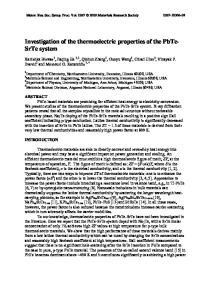Improvement of the Thermoelectric Properties of the Chimney-Ladder Compounds in the Ru-Mn-Si System
- PDF / 3,051,185 Bytes
- 6 Pages / 612 x 792 pts (letter) Page_size
- 90 Downloads / 297 Views
1218-Z06-09
Improvement of the Thermoelectric Properties of the Chimney-Ladder Compounds in the Ru-Mn-Si System Norihiko L. Okamoto, Yutaka Hashimoto, Tatsuya Koyama, Hiroki Adachi, Kyosuke Kishida, Katsushi Tanaka and Haruyuki Inui Department of Materials Science and Engineering, Kyoto University, Sakyo-ku, Kyoto 606-8501, Japan ABSTRACT Directionally solidified alloys in the Ru-Mn-Si system exhibit a particular microstructure including columnar compositional variation due to the formation of many different chimneyladder phases along the growth direction. Despite the existence of the compositional variation, the crystal orientations of the neighboring chimney-ladder phases are preserved. Over the compositional interfaces, the metal sublattice is considered to be continuous while the Si sublattice is not. Heat treatment of the directionally solidified alloy with the nominal composition of Ru0.10Mn0.90Si1.732 at 1100°C coarsens the compositional domains so as to reduce the density of the compositional interfaces. The values of the thermal conductivity increase with the decrease in the density of the compositional interfaces whereas those of the Seebeck coefficient and electrical resistivity are almost unchanged after the heat treatment. It is considered that the thermoelectric properties of the chimney-ladder compounds in the Ru-Mn-Si system can be enhanced by introducing a high density of the compositional interfaces. INTRODUCTION Thermoelectric materials have been of great interest because they can generate electricity from waste heat. The thermoelectric performance is evaluated with the dimensionless figure-ofmerit, ZT = α2T/ρλ, where α, ρ, λ and T stand for Seebeck coefficient, electrical resistivity, thermal conductivity, and absolute temperature, respectively. Generally, it is difficult to obtain high ZT materials because α, ρ and the carrier component of λ are functions of the carrier concentration. The reduction of the lattice component of λ without degrading the electrical properties is required. On the basis of this requirement, phonon-blocking-electron-transmitting (PBET) concept was suggested and has been embodied in artificial superlattices, such as Bi2Te3/Sb2Te3, exhibiting a ZT value as high as 2.4 [1]. However, it is not only laborious to fabricate these superlattices but also difficult to apply a large temperature gradient between both sides of a thin film of superlattices. Therefore, it is desired to seek for bulk materials that embody the PBET concept. Bulk thermoelectric chimney-ladder silicides, such as Ru2Si3, Mn4Si7 and so forth, are known to possess a particular tetragonal crystal structure [2-3]. Chimney-ladder silicides expressed with the general chemical formula of MnSi2n-m (M: transition metal element, n, m: integers) possess a unit cell consisting of nM subcells with the atomic arrangement of the β-Sn type (chimney) and mSi subcells with the atomic arrangement of a coupled helices (ladders) with both the chimney and ladder being aligned along the c-axis of the tetragonal unit cell [4-5].
Data Loading...











